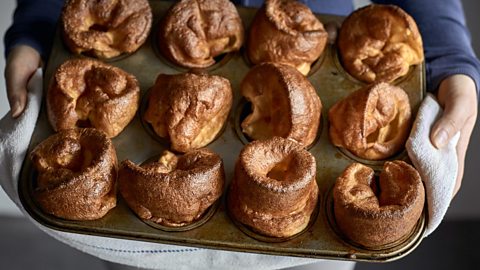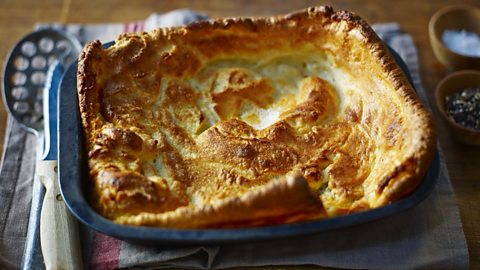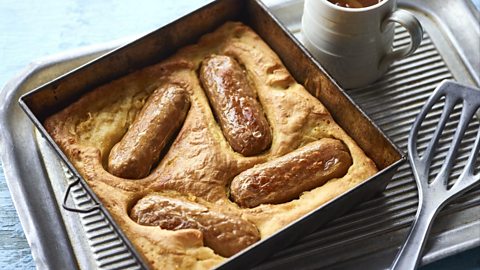‘Why do they always go wrong?’ Your questions on Yorkshire puddings answered
We all love ’em, but they can be tricky to master. It seems everyone has a different opinion about how to get Yorkshire puddings right – so here is your definitive guide to nailing those puds.

They are an intrinsic part of our Sunday roast and without them, toad in the hole wouldn’t even exist (shudder), but do you avoid making your own Yorkshire puddings because of all the pitfalls and seeming unpredictability of the results?
Many people turn to shop-bought puds for ease. Yet, Yorkshire puddings can be really simple to make, and there’s no need to listen to all of the oft-circulated advice on how to make them. (Contrary to popular belief, opening the oven door while they’re cooking is – gasp! – unlikely to render your Sunday lunch an unmitigated disaster that you’ll never live down.)
We asked you what issues you most encounter with these puds and what questions you had about making them, and your . Here’s what you wanted to know.
‘Should I be using water in the batter as well as milk?’
Yorkshire pudding batter has just three ingredients – milk, eggs and flour – but the addition of water can make the finished result puffy and light. The fat content of the milk and eggs brings richness, but it’s the water that helps them crisp up.
So, if you want them rich and chewy then stick with just milk, but if that crisp and light texture is your bag, get some water involved too. Just sub half of the milk for water, so that the wet to dry ingredient ratio doesn’t change. For instance, if a recipe suggests 200ml milk (and no water), try using 100ml milk and 100ml water.
Mary Berry’s Yorkshire pudding recipe is easy and foolproof
‘Can you use self-raising flour?’
It may seem logical that self-raising flour will give Yorkshire puddings more height, but those extra raising agents aren’t required. In fact, they can have the opposite effect and result in a flat pudding. You should always use plain flour – except, perhaps, if you’re making vegan Yorkies. (More on that later.)
‘Do you really need to rest your batter – and for how long?’
Advice varies from resting for just 20 minutes to overnight. Resting allows the starches and proteins to break down and the gluten to relax, which will not only improve the texture of your puds (think light and fluffy) but also the taste. If you don’t rest the batter, it doesn’t mean you’re in for a disastrous result, but those Yorkies won’t have the stretchiness or well-developed flavour that they could have had with a bit of relaxation before going into the oven.
‘Why are they coming out flat?’
There are a number of reasons why they might not be reaching the heights you hope, but most commonly it’s down to the oven or oil not being at the right temperature when the batter goes in. The oven should be hot – we’re talking 220C/200C Fan/Gas 6.
Preheating your pan and oil (as well as your oven) ensures that steam will form as soon as the batter goes into it, causing it to puff up and get that glorious rise. On a practical level, it also means that the batter is far less likely to stick to the pan. If the batter sizzles as it’s poured in, you know you’re on the right track.
Given the high temperature you’re cooking at, choose an oil that has a high smoking point, such as sunflower oil or vegetable oil.
Traditional Yorkshire pudding
Rather than individual puds, why not make a large one? This Delia Smith recipe is always a winner

‘Why are they so greasy?’
This is about the oil. As mentioned, you need the oil to be very hot before adding your batter, but it’s also important to use the right amount. Too much will make the bottom of your Yorkshires greasy, while too little could see your puds stick to the pan.
It always pays to measure out the right amount – try and use a recipe that specifies the quantity of fat to use. If they do come out a touch greasy, just pop them on a little kitchen paper before serving, which will absorb some of that excess oil. Or you could follow the advice of Adebola Adeshina, chef patron at The Chubby Castor, Cambridgeshire, who suggests that once you’ve cooked your puds, you quickly flip them upside down and return to the oven for two minutes to dry out those bases and avoid any sogginess.
‘Why are they sinking before I serve them?’
It’s true that if cooked Yorkshire puddings are left hanging around, they will sink and become lacklustre – so plan your meal to allow you to pull them out of the oven and get them straight onto your plates.
If you’re concerned that they’ve sunk because you’ve opened the oven door during the cooking process, there’s no evidence to show that it’d lead to an unmitigated disaster. The batter is so moist that there will still be enough steam in the oven for the puddings to rise.
Related stories
‘How can I make them gluten free?’
Gluten-free cooking expert has spent years perfecting her Yorkshire puddings and says the key is to keep things simple.
“Yorkshire puddings are one of the easiest things to make gluten free as you don’t need any specialist ‘free from’ products. All you need are eggs, milk and… cornflour!
“Cornflour creates lovely light Yorkshire puddings. But be warned – they come out huge! If you don’t have cornflour, you can also use tapioca starch as a like-for-like swap, which creates equally fabulous Yorkshire puds. Avoid using a gluten-free flour blend as that tends to contain a mix of ingredients (including rice flour) which is heavier so leads to a less crisp and puffed-up pud. Also, flour blends are specialist ‘free from’ products so more expensive than simple cornflour.”
‘Would they work in an air fryer?’
Absolutely – just perhaps with a tiny tweak. Adeshina suggests you follow your regular recipe and method but adjust your cooking time as “they’ll need five minutes less in an air fryer.”
Depending on your model of air fryer though, the issue of space may be a deal breaker. If you want more than a couple, it’s going to be a struggle.
‘Can you make vegan Yorkshire puddings?’
Yes, is the short answer. However, it’s not just the eggs and milk you’ll want to swap for alternatives. Karen Lee says that instead of plain flour you should opt for a mix of self-raising and chickpea or gram flour, and also add a little baking powder. This is because the egg would traditionally help your puds to rise, so without it, they need a little bit of help. If you stuck to plain flour, you’d need a heftier amount of baking powder to get that lift, which could give your Yorkies a metallic taste. Likewise, the gram flour (which she recommends you sieve to avoid lumps) will help thicken the batter.
To make vegan Yorkshires, mix 75g/2¾oz self-raising flour, 75g/2¾oz gram or chickpea flour, ¼ teaspoon salt, ¼ teaspoon ground turmeric (for colour) and 1½ teaspoons baking powder in a bowl. In a separate bowl or jug, combine 90ml/3¼oz aquafaba, 180ml/6½oz soya milk and 180ml/6½oz water, then pour into the dry ingredients. Whisk well, add 10ml/⅓oz vinegar and continue to whisk – don’t be put off if the mix looks slightly curdled. Set your batter aside. Add a generous teaspoon of oil to each hole of a muffin tin and heat it in the oven at 220C/200C Fan/Gas 7. When the oven and oil are very hot, add the batter to the tin and cook for about 30 minutes, or until the Yorkies are nicely golden.
Vegan toad in the hole with red onion gravy
If you don’t eat dairy or eggs, toad in the hole is not off the table for you

‘When I’m making toad in the hole, should I pre-cook the sausages?’
You’ll want to brown the sausages first (no need to cook them thoroughly at this stage, though) in your oven dish with around three tablespoons of oil. This serves two purposes: firstly, the oil will become flavoured with the sausage meat so improve the taste of your batter and, secondly, if your Yorkshire pudding browns quickly and needs to come out the oven, you won’t have to run the risk of those sausages not being cooked all the way through.
It’s also worth bearing in mind that sausages vary wildly in terms of their fat content, which means the amount of liquid that leaks out while they are cooking will differ depending on which you use. Once you remove the heated pan from the oven (before adding the batter), check to see if it looks a little dry. If so, add more oil and pop it back in the oven to heat up before pouring in the batter. If you’re feeling lavish, you could add a little lard which, with its high saturated fat content, will make for a crispy batter.
‘How can I get an even rise on my batter when making toad in the hole?’
Lots of people seem to struggle with this: the batter on the outer side of the sausages – especially at the ends – rises high, but the batter between the sausages stays flat. If you want some puffiness in the middle too, the first thing to think about is what type of dish you’re using.
A metallic dish will reach a higher temperature faster than a ceramic one, helping to give a good rise. Also, if the tin is too small, the batter will be too deep so won’t rise as high. To gauge the right size, this recipe, which makes four servings, suggests using a roasting tray which is about 30x20x6cm/12x8x2½in. So, if the one you’re using is considerably smaller, divide the mix into two dishes instead.
Chef Michael Wignall from The Angel in the Yorkshire Dales, adds that making the batter the night before and then bringing it out of the fridge to get to room temperature before cooking means you’re less likely to have that stodgy, flat outcome.
Sage and onion Yorkshire puddings
These sage and onion Yorkshire puddings are perfect with roast pork or chicken

If you’re concerned that the outside of the pudding is browning while the middle isn’t, you could always pop foil on top for the last few minutes to stop the corners burning, while still allowing the mix in the middle more time to cook.
Want to know what to serve it with? Now make:
Originally published October 2023